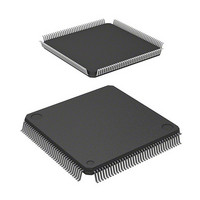HD6417708RF100A Renesas Electronics America, HD6417708RF100A Datasheet - Page 132

HD6417708RF100A
Manufacturer Part Number
HD6417708RF100A
Description
IC SUPERH MPU ROMLESS 144LQFP
Manufacturer
Renesas Electronics America
Series
SuperH® SH7700r
Datasheet
1.HD6417708SF60V.pdf
(635 pages)
Specifications of HD6417708RF100A
Core Processor
SH-2
Core Size
32-Bit
Speed
100MHz
Connectivity
EBI/EMI, SCI, SmartCard
Peripherals
POR, WDT
Number Of I /o
8
Program Memory Type
ROMless
Voltage - Supply (vcc/vdd)
3.15 V ~ 3.6 V
Oscillator Type
External
Operating Temperature
-20°C ~ 75°C
Package / Case
144-LQFP
Lead Free Status / RoHS Status
Contains lead / RoHS non-compliant
Eeprom Size
-
Ram Size
-
Program Memory Size
-
Data Converters
-
Available stocks
Company
Part Number
Manufacturer
Quantity
Price
Company:
Part Number:
HD6417708RF100A
Manufacturer:
Renesas Electronics America
Quantity:
10 000
Part Number:
HD6417708RF100A
Manufacturer:
HITACHI/日立
Quantity:
20 000
Part Number:
HD6417708RF100AV
Manufacturer:
RENESAS/瑞萨
Quantity:
20 000
- Current page: 132 of 635
- Download datasheet (3Mb)
6.2.3
On-chip supporting module interrupts are generated by the following five modules:
Not every interrupt source is assigned a different interrupt vector. Sources are reflected on the
interrupt event register (INTEVT). It is easy to identify sources by using the values of the
INTEVT register as branch offsets (in the exception handler routine).
The priority level (from 0–15) can be set for each module by writing to interrupt priority setting
registers A–B (IPRA–IPRB).
The interrupt mask bits (I3–I0) in the status register are not affected by the on-chip supporting
module interrupt handling.
On-chip supporting module interrupt source flag and interrupt enable flag updating should only be
performed when the BL bit in the status register (SR) is set to 1. To prevent acknowledgment of an
erroneous interrupt from an interrupt source that should have been updated, first read the on-chip
peripheral register containing the relevant flag, then clear the BL bit to 0. This will secure the
necessary timing internally. When updating a number of flags, there is no problem if only the
register containing the last flag updated is read.
If flag updating is performed while the BL bit is cleared to 0, the program may jump to the
interrupt service routine when the INTEVT register value is 0. In this case, interrupt handling is
initiated due to the timing relationship between the flag update and interrupt request recognition
within the chip. Processing can be continued without any problem by executing an RTE
instruction.
6.2.4
Table 6.3 lists the codes for the interrupt event register (INTEVT), and the order of interrupt
priority. Each interrupt source is assigned unique code. The start address of the interrupt handler is
common to each interrupt source. This is why, for instance, the value of INTEVT is used as offset
at the start of the interrupt handler and branched to identify the interrupt source.
The order of priority of the on-chip supporting module is set within the priority levels 0–15 at will
by using the interrupt priority level set in registers A and B (IPRA–IPRB). The order of priority of
the on-chip supporting module is set to zero by a reset.
112
Timer unit (TMU)
Realtime clock (RTC)
Serial communication interface (SCI)
Bus state controller (BSC)
Watchdog timer (WDT)
On-Chip Supporting Module Interrupts
Interrupt Exception Handling and Priority
Related parts for HD6417708RF100A
Image
Part Number
Description
Manufacturer
Datasheet
Request
R

Part Number:
Description:
KIT STARTER FOR M16C/29
Manufacturer:
Renesas Electronics America
Datasheet:

Part Number:
Description:
KIT STARTER FOR R8C/2D
Manufacturer:
Renesas Electronics America
Datasheet:

Part Number:
Description:
R0K33062P STARTER KIT
Manufacturer:
Renesas Electronics America
Datasheet:

Part Number:
Description:
KIT STARTER FOR R8C/23 E8A
Manufacturer:
Renesas Electronics America
Datasheet:

Part Number:
Description:
KIT STARTER FOR R8C/25
Manufacturer:
Renesas Electronics America
Datasheet:

Part Number:
Description:
KIT STARTER H8S2456 SHARPE DSPLY
Manufacturer:
Renesas Electronics America
Datasheet:

Part Number:
Description:
KIT STARTER FOR R8C38C
Manufacturer:
Renesas Electronics America
Datasheet:

Part Number:
Description:
KIT STARTER FOR R8C35C
Manufacturer:
Renesas Electronics America
Datasheet:

Part Number:
Description:
KIT STARTER FOR R8CL3AC+LCD APPS
Manufacturer:
Renesas Electronics America
Datasheet:

Part Number:
Description:
KIT STARTER FOR RX610
Manufacturer:
Renesas Electronics America
Datasheet:

Part Number:
Description:
KIT STARTER FOR R32C/118
Manufacturer:
Renesas Electronics America
Datasheet:

Part Number:
Description:
KIT DEV RSK-R8C/26-29
Manufacturer:
Renesas Electronics America
Datasheet:

Part Number:
Description:
KIT STARTER FOR SH7124
Manufacturer:
Renesas Electronics America
Datasheet:

Part Number:
Description:
KIT STARTER FOR H8SX/1622
Manufacturer:
Renesas Electronics America
Datasheet:

Part Number:
Description:
KIT DEV FOR SH7203
Manufacturer:
Renesas Electronics America
Datasheet:











